The AC4400CW was introduced in 1993 as an AC-powered version of GE’s Dash 9-44CW (a DC locomotive that Kato also produced as an HO model in 1996). Its AC traction motors and electrical system make the AC4400CW more efficient and reliable in heavy-haul service than comparable DC units. There are more than 2,200 of these locomotives in service.
The AC4400CW’s carbody is similar to the Dash 9’s, except for some vents and the addition of a large box behind the cab on the left side. This box is part of the inverter cabinet that holds most of the AC traction circuitry. On the right side, the primary spotting feature is the set of louvers beneath the cab.
Kato’s model matches the overall dimensions of a prototype drawing in the April 1996 Model Railroader, but its details reflect later production variations. Its GE model number indicates that the locomotive is AC powered, produces 4,400-hp, rides on six-wheel trucks (C-C), and has a modified North American cab.
A four-page 8¼” x 11½” instruction sheet includes exploded isometric drawings and diagrams that identify the numbered parts on the sprues and show their locations on the model in red. I used a pair of sprue nippers to trim the small parts off the sprues, a pair of modeler’s serrated-jaw pliers to gently handle and press the parts into the holes, and a Phillips screwdriver to remove and install the couplers.
Each body shell contains more than 20 superbly detailed pieces that include individual railroad options such as number board and sandbox locations. Everything comes neatly painted and lettered, so take care to avoid damaging the finish as you install the grab irons and small detail parts.
The cab has flush-fitting clear window inserts and a tan interior. A variety of tiny concealed latches lock the main body parts together, while the small details press-fit into holes provided in the castings. These items included numerous grab irons, multiple-unit hoses, a snowplow, uncoupling levers, and windshield wipers.
The railings are molded in two colors of acetal plastic. All of the vertical corner handrails are cast in white, and they press-fit into tiny sockets molded into the gray end stanchions. This neatly provides the high-visibility contrasting color required by safety regulations.
A printed circuit board mounted on top of the motor supports the golden-white light-emitting-diode (LED) headlights and their control circuitry. This PC board also holds an NMRA-recommended eight-pin DCC receptacle with jumper plugs. A recess within the fuel tank can hold a 1″-diameter speaker for use with a sound decoder.
While the locomotive alone will negotiate an 18″-minimum radius, its overhang is severe. Kato recommends larger curves (24″ radius and wider) for best performance.
Kato magnetic knuckle couplers are mounted at the correct height with small Phillips screws. Kadee no. 5 or similar couplers can be easily substituted.
The AC4400CW is a widely used contemporary road locomotive that looks great and performs well by itself or in consists with Kato’s earlier C44-9 locomotives.
Price: UP units, $155.00 each;
CEFX units, $150.00 each
Manufacturer:
Kato U.S.A. Inc.
100 Remington Rd.
Schaumburg, IL 60173
www.katousa.com
Description:
Plastic-and-metal locomotive
Features:
Cab interior
Drawbar pull: 6.08 ounces
Dual flywheel drive
Engine weight: 18 ounces
Flush-mounted window glazing
Golden White light-emitting
diode constant directional
headlights and ditch lights
Kato magnetic knuckle couplers
Minimum radius: 18″
NMRA-recommended Digital
Command Control socket
NMRA RP-25 wheels (in
gauge)
12-wheel drive and electrical
pick-up
Road Names:
Union Pacific with United States
flag (nos. 5714 and 5799), UP
“lightning bolt” (nos. 5727 and
5767), CEFX Leasing (nos.
1006 and 1021)





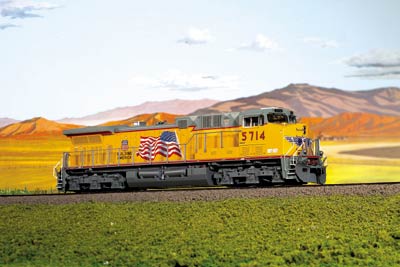
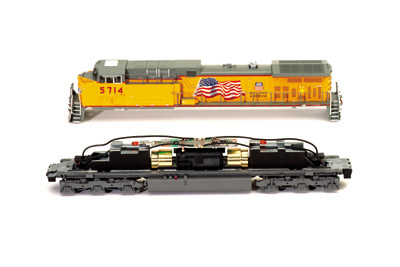
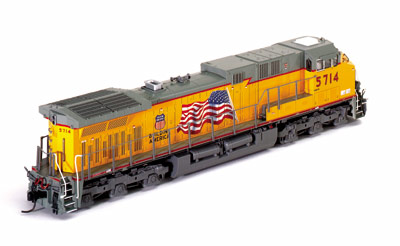
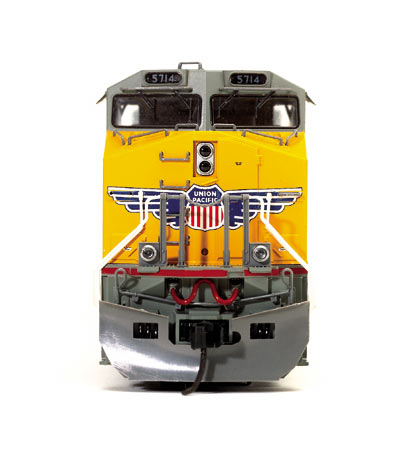
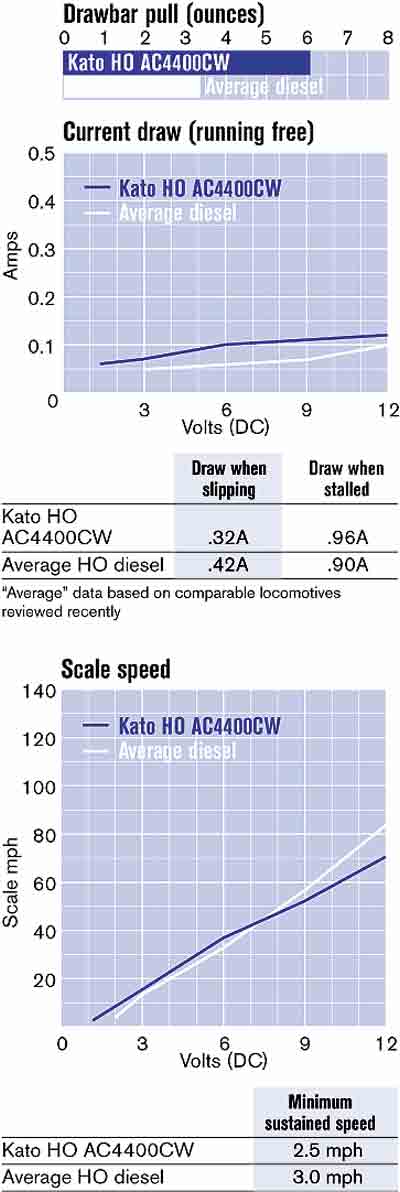









I have the BNSF version. I added Soundtraxx Tsunami sound. Very easy, straightforward install. Runs extremely smooth. Speaker housings provide great sound. Nice led lights, good pulling power, excellent runner.
seems to have a lot of the same specs that my athern -9 has
Looks like a great model I am looking foward to buying one that has sound and DCC